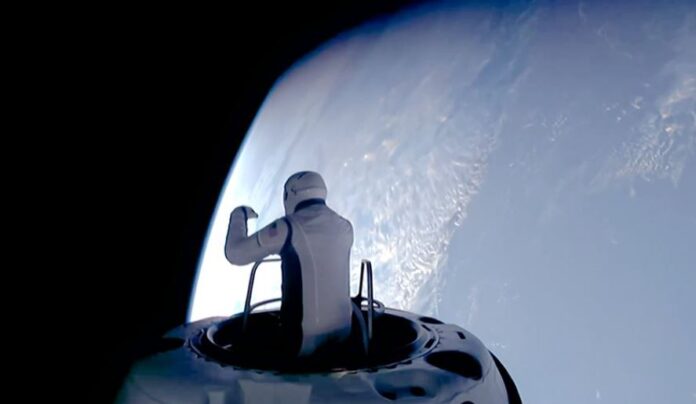The SpaceX Dragon spacecraft carrying the Polaris Dawn crew has successfully splashed down, marking a triumphant conclusion to a historic mission. After venturing further into space than any human crew in half a century, the four-member team, led by billionaire entrepreneur Jared Isaacman, returned safely to Earth on Sunday, September 15.
Billionaire entrepreneur Jared Isaacman, 41, made history on Thursday, September 12, as he floated in space tethered to the Dragon capsule, becoming the first private citizen to conduct a spacewalk. Isaacman, the founder and CEO of Shift4 Payments, had previously financed the first fully commercial spaceflight in 2021 under a deal with SpaceX, and now leads the Polaris Dawn mission.
Joining Isaacman on this mission were SpaceX engineers Anna Menon and Sarah Gillis, along with mission pilot Scott Poteet, a retired U.S. Air Force lieutenant colonel. Together, they launched from the Kennedy Space Center on Tuesday and ventured into the Van Allen radiation belt, reaching an altitude of 870 miles (1,400 kilometers) — the furthest humans have traveled from Earth since the Apollo missions.
Isaacman and Gillis both exited the spacecraft for about 15 minutes during the spacewalk, testing the mobility and functionality of SpaceX’s next-generation spacesuits, which are designed for future missions to Mars and beyond. The crew’s movements were closely monitored, and the spacesuits performed well under the harsh conditions of space. These advancements, SpaceX hopes, will play a critical role in the company’s future deep space exploration missions.
Despite the lack of an airlock in the Dragon capsule, the crew managed the spacewalk with precision. Isaacman’s view of Earth from space captivated both mission control and viewers around the world, as he remarked, “From here, Earth sure looks like a perfect world.” His inspiring words were met with applause from the SpaceX mission control center in Hawthorne, California.
In addition to the spacewalk, the crew has been conducting a series of scientific experiments, including medical research to study the effects of space travel on the human body. One notable experiment involved using endoscopic cameras to monitor their airways, which could provide vital insights for long-duration space missions.
In a more artistic moment, Sarah Gillis played a violin solo of “Rey’s Theme” from Star Wars, while transmitting high-resolution footage to ground control using SpaceX’s Starlink satellite network.
This mission is the first of three planned under the Polaris program, a partnership between Isaacman and SpaceX. While financial details of the collaboration remain undisclosed, Isaacman reportedly invested $200 million of his own funds to lead the all-civilian SpaceX Inspiration4 mission in 2021. The final Polaris mission aims to include the first crewed flight of SpaceX’s Starship, a prototype rocket key to Elon Musk’s vision for interplanetary travel.
As the Dragon capsule prepares for re-entry into Earth’s atmosphere, its four main parachutes have successfully deployed, setting the stage for a safe splashdown. This mission has been hailed as a significant leap forward for both SpaceX and the future of commercial space exploration.
About the Mission: Key Achievements
- First All-Civilian Spacewalk: The Polaris Dawn crew made history by conducting the first-ever spacewalk carried out by an entirely civilian team.
- Reached 700 km Orbit: The mission reached an altitude of 700 kilometers, nearly double the height of the International Space Station’s orbit, pushing the boundaries of human space exploration.
- Testing SpaceX EVA Suits: The crew tested SpaceX’s Extra Vehicular Activity (EVA) suits, designed for future deep-space missions, during their spacewalk, evaluating their functionality and mobility.
- Studying Human Body in Deep Space: The mission included scientific research focused on studying the human body’s reactions to deep-space conditions, providing critical insights for long-duration space travel.
Key Points
Mission Overview:
- SpaceX Dragon capsule carrying the Polaris Dawn crew is returning to Earth on Sunday, September 15.
- Historic mission included the first-ever private spacewalk, representing a key moment for space tourism and SpaceX.
Key Figures:
- Jared Isaacman, 41, billionaire entrepreneur, led the mission. Previously financed the first fully commercial spaceflight in 2021.
- Crew members: Anna Menon and Sarah Gillis (SpaceX engineers) and Scott Poteet (retired U.S. Air Force lieutenant colonel, mission pilot).
Major Milestones:
- Crew reached 870 miles (1,400 km) in altitude, the furthest any humans have traveled from Earth since the Apollo missions.
- Isaacman and Gillis conducted a 15-minute spacewalk, testing SpaceX’s next-generation spacesuits.
Scientific Contributions:
- Crew conducted 40 science experiments, including endoscopic imaging of their airways to study the effects of long-duration space travel.
- Demonstrated communication with SpaceX’s Starlink satellite constellation, transmitting high-resolution footage of a violin performance by Gillis.
Polaris Program:
- Polaris Dawn is the first of three missions in the Polaris program, a partnership between Isaacman and SpaceX.
- The final mission is expected to feature the first crewed flight of SpaceX’s Starship rocket.
Return and Splashdown:
- Dragon capsule’s parachutes have deployed for a safe splashdown on Sunday.
- Mission is a significant achievement for SpaceX and a leap forward for commercial space exploration.



